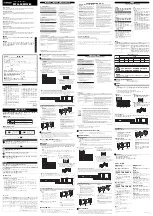
Leaders in Pipelin
e Survey Systems
C
C
C
-
-
-
S
S
S
C
C
C
A
A
A
N
N
N
2
2
2
0
0
0
1
1
1
0
0
0
SYSTEM MANUAL Version 6.03i
19
4. SIGNAL GENERATOR - FIELD OPERATIONS
4.1. Operating Environments
The Signal Generator is housed in a strong weatherproof high impact structural copolymer
case, but it is not designed for total immersion and is
not certified for use in hazardous
areas
. The Signal Generator will operate between -4
o
F and +104
o
F. The efficiency of the
battery however, is reduced under extremes of temperature. If internal temperatures
reach 165
º
F, the Signal Generator will automatically shut down and display a warning
message that it is in ‘cooling mode’. Once temperatures have dropped the output will
automatically restart at the previous current setting.
Note
: As the lid must be open during use, it is advisable to shade the Signal Generator
from direct strong sunlight as this may cause overheating.
4.2. Survey Information
Before a survey takes place it is recommended that as much detail as possible about the
pipeline is gathered first. Information such as river or road crossings, bends, T-sections
etc., will prove invaluable to the surveyor when in the field. See section 6.3 –planning a
Survey.
4.3. Connection to Pipeline
Before connecting to the pipeline, three important considerations have to be taken into
account: 1) The location of a suitable injection point, 2) The potential for
damaging
AC
currents and DC voltages existing on the line, and 3) The initial signal interference incurred
when connecting to a pipeline. These are discussed in more detail below:
4.3.1. Location of Injection Point
To begin a survey the Signal Generator must first be connected to the pipeline being
surveyed – the Signal Injection Point. Selecting a good injection point is a key part of the
surveying process. When selecting the injection point it should be remembered that in
most cases the applied signal will travel in both directions from the Injection Point, and that
the Detector can operate moving towards the Injection Point (Signal Generator) as well as
away from it. Surveying away from the Injection Point will see decreasing current values
and hence positive attenuation values, while surveying towards the Injection Point will see
increasing current values and therefore negative attenuation values. It is always
recommended to survey away from the Injection Point so as to obtain positive attenuation
values and never to survey across the Injection Point. Although these mistakes can be
amended in DCAPP after downloading the survey, it is good practice to get into the habit
of proper survey techniques from the start. Once the survey direction and area to be
surveyed have been established a suitable injection point will need to be found, such as a
Cathodic Protection (CP)Test Post, Transformer-Rectifier (TR) Station, valve or similar.
4.3.2. Check Pipeline
Before connecting the Signal Generator to the pipeline it is
very important
to confirm if
any AC currents or DC voltages exist on the pipeline being surveyed. Although the Signal
Generator contains protection circuitry, this should only be relied upon as a last resort and
all
surveys should begin with the following procedure:
•
Disconnect all CP stations and cross-bonds to other pipelines within 3000ft
•
Connect the Pipe and Ground leads to the pipeline and suitable earth, but do not
connect to the Signal Generator yet. Using a multi-meter set to AC current, connect
between the
Pipe
and
Ground
leads. If the meter indicates a value above 100mA
RMS then there is a foreign AC signal on the line – DO NOT CONNECT SIGNAL
GENERATOR
















































